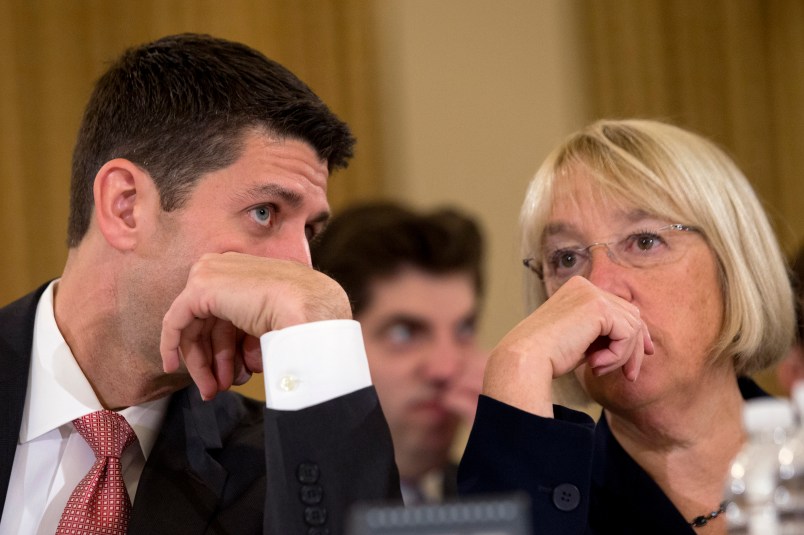The chief Democrat and Republican budget negotiators are nearing a possible agreement to roll back a portion of the across-the-board spending cuts known as sequestration.
Talks remain fluid and sources caution that a possible deal could still fall apart. But Senate Budget Chair Patty Murray (D-WA) and House Budget Chair Paul Ryan (R-WI) are said to be more optimistic about an agreement than they have been. They’ve been speaking regularly and exchanging offers, and have narrowed the scope of the discussions to the more achievable goal of replacing the sequester for two or three years. No grand bargain, no long-term deal.
The tricky part is how to satisfy each party’s red line by the Dec. 13 deadline for the budget conference. The contours of the potential deal are as TPM reported in late October. There is broad agreement that a portion of the sequester should be replaced with targeted cuts to discretionary spending. But Democrats demand revenues in the mix and Republicans categorically reject new taxes. So to thread that needle, sources familiar with the negotiations say, Murray and Ryan are weighing revenues in the form of asset sales and government fees, rather than Democrats’ preference for raising revenue by scaling back tax loopholes.
“They continue to talk, they continue to work and negotiate,” said a Democratic Senate leadership aide. “Senator Murray remains hopeful that they can get a deal by the deadline.”
That’s the spirit of the recent negotiations. Murray is flying back to Washington this week for a face-to-face meeting with Ryan to hash out the lingering disputes. (The House is in session but the Senate is not.) The talks have been boosted by a strong Democratic appetite to do away with the sequester as well as a push by GOP defense hawks and appropriators to replace the deep cuts to military programs. Their offices wouldn’t comment on the specific proposals being traded — usually a sign that negotiations are getting serious.
“Surely there isn’t going to be any Republican support for increases in taxes through the tax code,” Sen. John Thune (R-SD) told TPM early in the negotiations. But he added: “There might be Republicans who would support some non-tax code revenues. I’m not suggesting I know who they are or what that number is.”
Just 10 days remain for the budget conference committee, initiated by the Oct. 16 law to re-open the government and lift the debt ceiling, to hash out a deal. Murray and Ryan are seen as ideal negotiators as they are influential with their respective rank-and-file members as well as leadership. But there remain several sticking points that could derail the talks.
The first is the topline spending level. Some conservatives, including Senate Minority Leader Mitch McConnell (R-KY), want next year’s spending figure to be no higher than $967 billion, the sequestration level called for by the Budget Control Act. But replacing some of the automatic cuts with non-tax revenues would necessitate lifting that cap, which won’t sit well with tea partiers who want to sustain every dollar of spending cuts they’ve extracted.
The second is Democrats want a balanced deal that addresses the sequester’s cuts to defense as well as domestic programs like health care, education and scientific research. Murray has drawn a line against a lopsided deal that unwinds the defense sequester but leaves the non-defense sequester in place. But Republicans are largely concerned with the military cuts and it’s unclear how much Ryan will compromise to get rid of the domestic cuts.
A more subtle landmine is Ryan’s rumored presidential ambitions for 2016. Any deal must have the tea party base’s seal of approval, lest Ryan damage his sterling conservative credentials with Republican primary voters. But that incentive works both ways: cutting a deal that’s acceptable to both conservatives and Democrats stands to boost his credibility on working across the aisle — another valuable asset for politicians with national ambitions.
If there is a deal by Dec. 13 that establishes spending levels for the coming years, Congress will have one month to pass appropriations bills and keep the government funded. Without a deal, there won’t be a budget, which means there may be yet another round of brinkmanship over a potential government shutdown when funding expires on Jan. 15.






